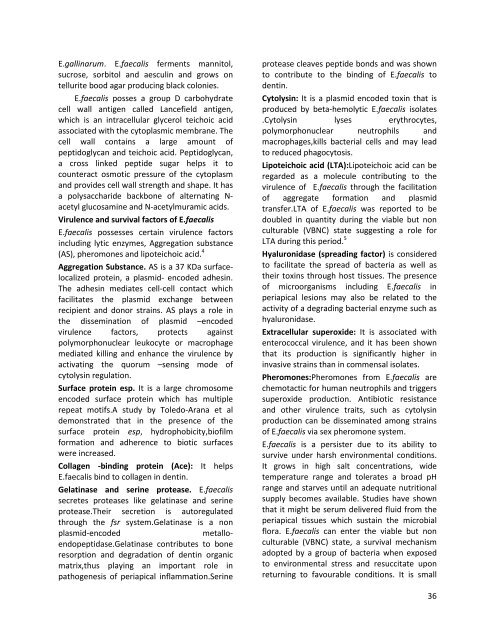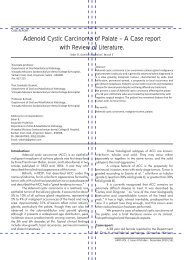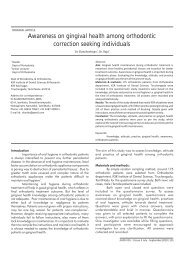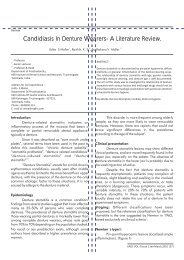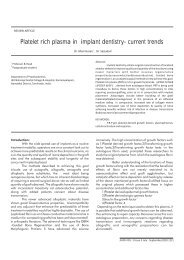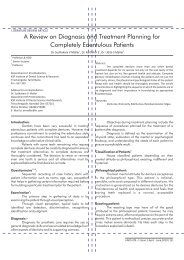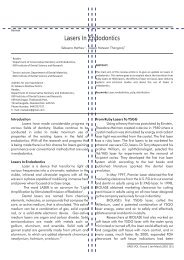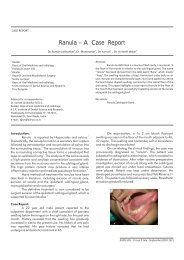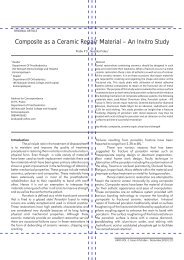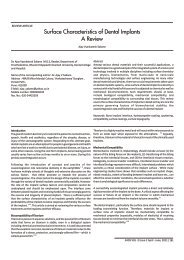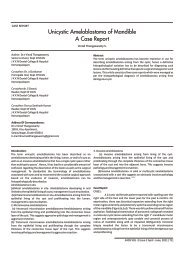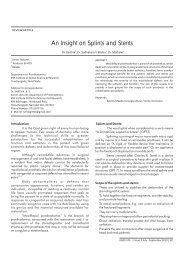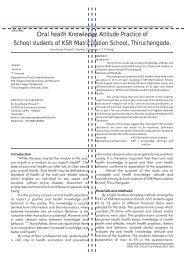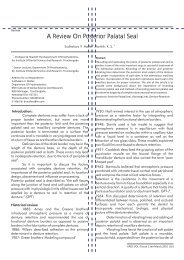Enterococcus faecalis -An Endodontic Challenge
Enterococcus faecalis -An Endodontic Challenge
Enterococcus faecalis -An Endodontic Challenge
You also want an ePaper? Increase the reach of your titles
YUMPU automatically turns print PDFs into web optimized ePapers that Google loves.
E.gallinarum. E.<strong>faecalis</strong> ferments mannitol,<br />
sucrose, sorbitol and aesculin and grows on<br />
tellurite bood agar producing black colonies.<br />
E.<strong>faecalis</strong> posses a group D carbohydrate<br />
cell wall antigen called Lancefield antigen,<br />
which is an intracellular glycerol teichoic acid<br />
associated with the cytoplasmic membrane. The<br />
cell wall contains a large amount of<br />
peptidoglycan and teichoic acid. Peptidoglycan,<br />
a cross linked peptide sugar helps it to<br />
counteract osmotic pressure of the cytoplasm<br />
and provides cell wall strength and shape. It has<br />
a polysaccharide backbone of alternating Nacetyl<br />
glucosamine and N-acetylmuramic acids.<br />
Virulence and survival factors of E.<strong>faecalis</strong><br />
E.<strong>faecalis</strong> possesses certain virulence factors<br />
including lytic enzymes, Aggregation substance<br />
(AS), pheromones and lipoteichoic acid. 4<br />
Aggregation Substance. AS is a 37 KDa surface-<br />
localized protein, a plasmid- encoded adhesin.<br />
The adhesin mediates cell-cell contact which<br />
facilitates the plasmid exchange between<br />
recipient and donor strains. AS plays a role in<br />
the dissemination of plasmid –encoded<br />
virulence factors, protects against<br />
polymorphonuclear leukocyte or macrophage<br />
mediated killing and enhance the virulence by<br />
activating the quorum –sensing mode of<br />
cytolysin regulation.<br />
Surface protein esp. It is a large chromosome<br />
encoded surface protein which has multiple<br />
repeat motifs.A study by Toledo-Arana et al<br />
demonstrated that in the presence of the<br />
surface protein esp, hydrophobicity,biofilm<br />
formation and adherence to biotic surfaces<br />
were increased.<br />
Collagen -binding protein (Ace): It helps<br />
E.<strong>faecalis</strong> bind to collagen in dentin.<br />
Gelatinase and serine protease. E.<strong>faecalis</strong><br />
secretes proteases like gelatinase and serine<br />
protease.Their secretion is autoregulated<br />
through the fsr system.Gelatinase is a non<br />
plasmid-encoded metalloendopeptidase.Gelatinase<br />
contributes to bone<br />
resorption and degradation of dentin organic<br />
matrix,thus playing an important role in<br />
pathogenesis of periapical inflammation.Serine<br />
protease cleaves peptide bonds and was shown<br />
to contribute to the binding of E.<strong>faecalis</strong> to<br />
dentin.<br />
Cytolysin: It is a plasmid encoded toxin that is<br />
produced by beta-hemolytic E.<strong>faecalis</strong> isolates<br />
.Cytolysin lyses erythrocytes,<br />
polymorphonuclear neutrophils and<br />
macrophages,kills bacterial cells and may lead<br />
to reduced phagocytosis.<br />
Lipoteichoic acid (LTA):Lipoteichoic acid can be<br />
regarded as a molecule contributing to the<br />
virulence of E.<strong>faecalis</strong> through the facilitation<br />
of aggregate formation and plasmid<br />
transfer.LTA of E.<strong>faecalis</strong> was reported to be<br />
doubled in quantity during the viable but non<br />
culturable (VBNC) state suggesting a role for<br />
LTA during this period. 5<br />
Hyaluronidase (spreading factor) is considered<br />
to facilitate the spread of bacteria as well as<br />
their toxins through host tissues. The presence<br />
of microorganisms including E.<strong>faecalis</strong> in<br />
periapical lesions may also be related to the<br />
activity of a degrading bacterial enzyme such as<br />
hyaluronidase.<br />
Extracellular superoxide: It is associated with<br />
enterococcal virulence, and it has been shown<br />
that its production is significantly higher in<br />
invasive strains than in commensal isolates.<br />
Pheromones:Pheromones from E.<strong>faecalis</strong> are<br />
chemotactic for human neutrophils and triggers<br />
superoxide production. <strong>An</strong>tibiotic resistance<br />
and other virulence traits, such as cytolysin<br />
production can be disseminated among strains<br />
of E.<strong>faecalis</strong> via sex pheromone system.<br />
E.<strong>faecalis</strong> is a persister due to its ability to<br />
survive under harsh environmental conditions.<br />
It grows in high salt concentrations, wide<br />
temperature range and tolerates a broad pH<br />
range and starves until an adequate nutritional<br />
supply becomes available. Studies have shown<br />
that it might be serum delivered fluid from the<br />
periapical tissues which sustain the microbial<br />
flora. E.<strong>faecalis</strong> can enter the viable but non<br />
culturable (VBNC) state, a survival mechanism<br />
adopted by a group of bacteria when exposed<br />
to environmental stress and resuccitate upon<br />
returning to favourable conditions. It is small<br />
36


